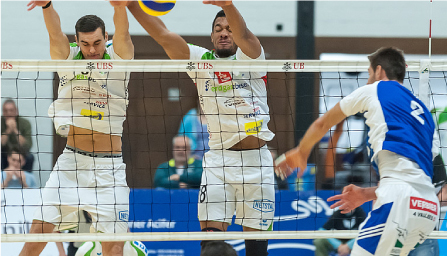In volleyball, scoring points often gets the spotlight, big swings, powerful serves, and fast-paced rallies. But what many players (and even coaches) overlook is that a great block can be just as game-changing. Blocking isn’t just about jumping high and hoping to touch the ball. It’s a coordinated, disciplined, and technical skill that can take years to master, especially when performed with a teammate in a double block.
Let’s break down what makes an elite-level block.
Reading the Play Before the Jump
Blocking starts before the ball is even set. Great blockers read the setter’s body language, hand position, and tempo to anticipate where the ball is going. This read helps determine whether to stay with your hitter, commit to the middle, or close the block to the outside.
In a double block scenario, this read must happen simultaneously between both blockers. If one player reads the wrong thing, the timing is off, and the block opens a seam.
Footwork and Setup
Footwork is everything. Blockers must move quickly but under control. The most common footwork patterns are:
- Crossover step for longer distances
- Shuffle step for short, controlled moves
- Hop step for middles making fast reads
Before jumping, blockers should be in a loaded stance — knees bent, weight slightly forward, hands above the head, and eyes on the hitter. The goal is to stay balanced and ready to explode upward.
Timing the Jump
The jump must be timed to meet the hitter at the peak of their swing — not too early, not too late. Jump too early, and the hitter will tool the block or hit around it. Jump too late, and you might not penetrate the net effectively.
In a double block, timing must be unified. If one player drifts or is delayed, the block becomes uneven, leaving gaps.
Hand Position & Penetration
Once airborne, the focus shifts to penetration, reaching over the net, not just above it. The hands should be:
- Strong and wide, fingers spread
- Angled slightly inward, creating a funnel to keep the ball in play
- Close together, to avoid gaps between teammates
Soft hands or a lack of wrist control can cause rebounds or tools, so it’s important that the block feels firm and controlled, not passive.
Decision-Making & Communication
Blocking is not just physical, it’s also mental. Players must:
- Decide whether to jump or hold
- Know when to commit or read
- Communicate constantly: “Line!” “Watch tip!” “Inside set!”
A strong block comes from clear communication between the outside and middle blockers ,deciding who will close, who will press more, and what zone they’re taking away.
The Goal of the Block
The primary goal isn’t always to score a point. Blocking success comes in many forms:
- Stuff block: Clean rejection for a point
- Soft touch: Slows the ball for your defense to transition
- Pressure: Forces the hitter to change their shot, often leading to errors
Blocking is one of the few moments where defense turns instantly into offense. A great block gives your team a chance to transition and score.
Summary
A successful block is more than a vertical leap, it’s the result of:
- Fast footwork
- Smart reading
- Unified timing
- Sharp communication
- Solid technique
At Alabama Cat5 Volleyball Academy, we train blocking as a core component of the game — just like serving or attacking. Whether you’re a middle, outside, or right-side, the ability to control the net is what separates a good team from a great one.




